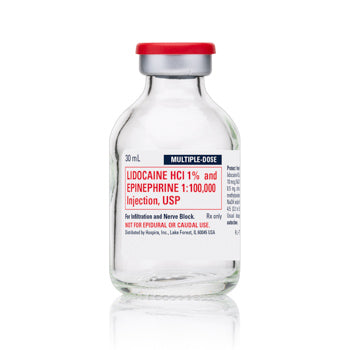Lidocaine 1% with Epinephrine 1% 1:100,000 for Injection 30 mL Multiple Dose, 25/Pack (Rx)
(Note: We don’t Fill Personal Prescriptions)
How to Order:
Lidocaine 1% with Epinephrine 1:100,000 for Injection is used as a local anesthetic to provide pain relief and reduce bleeding during surgical, medical, and dental procedures. Lidocaine works by blocking nerve signals to numb the treatment area, while epinephrine acts as a vasoconstrictor, narrowing blood vessels to prolong the anesthetic effect and minimize bleeding. This combination is ideal for procedures requiring effective and lasting anesthesia with improved surgical field visibility, enhancing precision and patient comfort during the intervention.
Lidocaine 1% with Epinephrine 1:100,000 Injection is a sterile solution used for local or regional anesthesia in various surgical and dental procedures. The combination includes lidocaine hydrochloride, a local anesthetic, and epinephrine, a vasoconstrictor. This formulation is provided in 30 mL multiple-dose vials, with each pack containing 25 vials. The addition of epinephrine helps to prolong the anesthetic effect and reduce local bleeding.
Details and Features:
Volume: 30 mL per vial
Packaging: 25 multiple-dose vials per pack
Concentration:
- Lidocaine Hydrochloride 1% (10 mg/mL)
- Epinephrine 1:100,000 (0.01 mg/mL)
Use: Indicated for local infiltration anesthesia, peripheral nerve blocks, and various other types of regional anesthesia
Vasoconstrictive Action: The presence of epinephrine helps to control bleeding and keeps the anesthetic localized, increasing the duration of action
Mechanism of Action:
- Lidocaine: Works by binding and inhibiting voltage-gated sodium channels in the nerve cells, preventing the initiation and propagation of nerve impulses. This leads to a reversible loss of sensation in the targeted area.
- Epinephrine: Acts as a vasoconstrictor by stimulating alpha-adrenergic receptors, which reduces blood flow in the area of injection. This prolongs the duration of action of lidocaine by decreasing its absorption rate into the bloodstream and also helps reduce local bleeding, providing a clearer surgical field.
Warnings:
-
Allergies: Contraindicated in individuals with a known hypersensitivity to lidocaine, epinephrine, or other amide-type local anesthetics.
-
Systemic Toxicity: Caution is advised to avoid overdosage or unintentional intravascular injection which may result in systemic toxic effects, including CNS disturbances (seizures) or cardiovascular effects (arrhythmias).
-
Cardiovascular Health: Use with caution in patients with severe heart disease, arrhythmias, or hyperthyroidism because epinephrine can exacerbate these conditions by increasing heart rate and blood pressure.
- Proper Administration Techniques: Ensure to aspirate before injecting to avoid intravascular administration. Limit the total lidocaine dose and consider patient-specific factors (e.g., weight, age, comorbid conditions).
Side Effects:
Potential side effects associated with Lidocaine 1% with Epinephrine Injection can include:
-
Local Reactions: Pain, swelling, or redness at the injection site
-
Central Nervous System Effects: Lightheadedness, dizziness, or in rare cases, confusion or seizures at toxic levels
-
Cardiovascular Effects: Increased heart rate, hypertension, palpitations, or arrhythmias, primarily due to the epinephrine component
-
Allergic Reactions: Though rare, signs may include rash, itching, or more severe reactions such as anaphylaxis
- Others: Numbness or tingling which generally subsides as the anesthetic effect diminishes
It is essential for administration to be performed by experienced healthcare professionals to manage anesthesia safely, monitoring for potential adverse effects, and employing proper dosing protocols tailored to the patient's individual medical profile.


